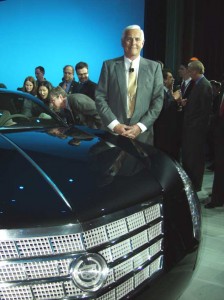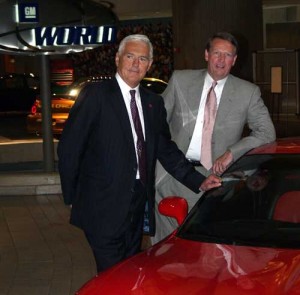
Shooting from the Lip, Bob Lutz and his L-29 Fighter
“Old soldiers don’t die,” began General Douglas MacArthur, “they just fade away.” For many years, one had to wonder what would ultimately happen to that one-time Marine fighter pilot, Bob Lutz, when his half-century career in the auto industry finally came to an end.
The 76-year-old son of a Swiss banker seemed to have more lives than a cat. Over the decades, he’s worked for BMW, Ford Motor Co., Chrysler Corp., the battery manufacturer, Exide, and, of course, General Motors – for whom Lutz came out of retirement, in 2001, to take over product development.
“At times, we really wondered if he would ever step down,” says a senior GM colleague, who admits being awed by the stamina of the septuagenarian, who more than occasionally flies himself to work in a private helicopter – part of a fleet of aircraft that includes a Czech-made L-29 Albatros fighter/trainer jet.
But, it seems even Lutz has his limits, and this morning, in a surprise announcement, GM revealed that its Vice Chairman will effectively hand over the reigns, at product development, on April 1, and formally retire at the end of 2009, his duties going to Tom Stephens, currently the tall and lanky overseer of GM’s powertrain operations.
“Tom is probably the polar opposite, in terms of personality,” says Joe Phillippi, chief of the AutoTrends consultancy, a bit taciturn and seldom likely to let loose with an off-the-cuff remark.

Lutz with the V-16-powered Cadillac Sixteen Concept, at 2004 Detroit Auto Show
A one-time semi-pro race car driver, Lutz is, in many ways a man from a different era, and very much cut from a different mold than the traditionally reticent, gray-flannel-suit executives at GM. Lutz has a history of shooting from the lip, which has made him a favorite of the media, but not always of the folks he has had to report to.
In 1990, Lutz helped scuttle the proposed merger of Chrysler and Fiat, angering his boss, Lee Iacocca, who stood to make millions on the deal. Then, four months later, when asked if Chrysler would need to find an alternative partner, in order to survive, Lutz blurted out that, “You can’t find a bridegroom when the bride is on her death bed.” Iacocca would have fired the Chrysler President were it not for the intervention of a sympathetic board member. Nonetheless, Lutz was bypassed when it came time for Iacocca to retire, the elder CEO bringing in former GM executive Bob Eaton as his successor.
In something of a surprise, Lutz stayed on at Chrysler, asserting that you don’t quit the team just because you’re not named captain. And, in the early 1996s, he helped spearhead the automaker’s renaissance. But he finally left when Eaton arranged a merger with the German automaker Daimler-Benz, a deal Lutz vehemently opposed.
The pilot was clearly not ready to fade away. He staged and abortive effort to launch a new sports car company, then went to work for the troubled battery maker, Exide. Then, in 2001, GM CEO Rick Wagoner paid a visit, asking Lutz if he could help the automaker come up with a new product development chief. “We agreed there was no one else who could do the job,” said Wagoner, at the time.
Ironically, Lutz had become one of GM’s worst critics, lambasting some of the automaker’s products, at the time, declaring that, “You can’t sell ugly cars,” and deriding some of GM’s futuristic concept vehicles as “angry toasters.”

Lutz, left, with General Motors CEO Rick Wagoner after joining the automaker in 2001
Directly reporting to Wagoner, Lutz tried to keep a bit more control of his lip, but it didn’t always work. Late last year, he generated headlines by admitting that he was a global warming skeptic.
Nonetheless, Lutz has also become a big believers in electric propulsion, which has numerous advantages, he claims. One of his biggest “scores” at General Motors was coming up with the concept for the Chevrolet Volt, a plug-in hybrid, or, as GM prefers, an “extended-range electric vehicle.” When it launches, late next year, Volt will be able to go 40 miles on a charge, more than enough for the typical daily commute. But when its batteries run down, the Chevy’s small internal combustion engine will kick in to keep it running.
Volt will be just one of the product programs Lutz will leave behind when he retires from GM. Other key programs include the highly-regarded Chevrolet Malibu, the reborn Camaro sports car, the next-generation Buick LaCrosse, and the Cadillac Converj, a luxury version of the Volt that may also be put into production.
Product will be only part of Lutz’s legacy, however, stresses analyst Phillippi. “He will be tested by the processes he left behind. We’ll see whether it can survive or get smothered by the old-style GM bureaucracy.”
Indeed, in an interview I had with Lutz shortly after he joined GM, he stressed that, “If all I do is come up with some good products but don’t change the system, when I leave, then I will not have succeeded.”
The push into “electrification,” at the least, is one major area where GM will be a very different company going forward.
Why Lutz is leaving now is a question that many will likely be asking. It’s been clear to those around him that he’s been frustrated by the automaker’s fall, and angered by the demands placed on GM by the lawmakers who debated a multi-billion-dollar bailout bill. Lutz was consciously left out when GM executives headed to Washington, in December, to plead for help. And he pointedly turned his back on one of GM’s Capitol Hill critics, Republican Senator Bob Corker, when the lawmaker visited the Detroit auto show, last month.
You can read our recent interview with Lutz by clicking here.

The last of the tell it like it is generation is tired of pandering to government nitwits…can’t say I’m surprised. It’s a shame to lose that kind of knowledge. He’ll remain as an adviser, but one can only wonder what that means. I feel sorry for his replacement…santized, media trained and not bullet proof like Lutz. Hopefully his plans to change the design culture have taken root.
In a sense, Lutz’s leaving is one of the true tests for GM. As I briefly touched on, in my story, Lutz made it very clear to me, years ago, when he joined the company, that he alone couldn’t save GM. Even if he did everything right — and he hasn’t — the best he really could do was get a few great products in the pipeline AND get the product development process working as it should, as a lean, efficient and truly customer-driven operation. If Lutz leaves and it’s back to business as usual, GM might as well pack up and shutdown now, saving taxpayers the extra $4 billion in guarantees it’s seeking.
Paul A. Eisenstein
Bureau Chief, TheDetroitBureau.com